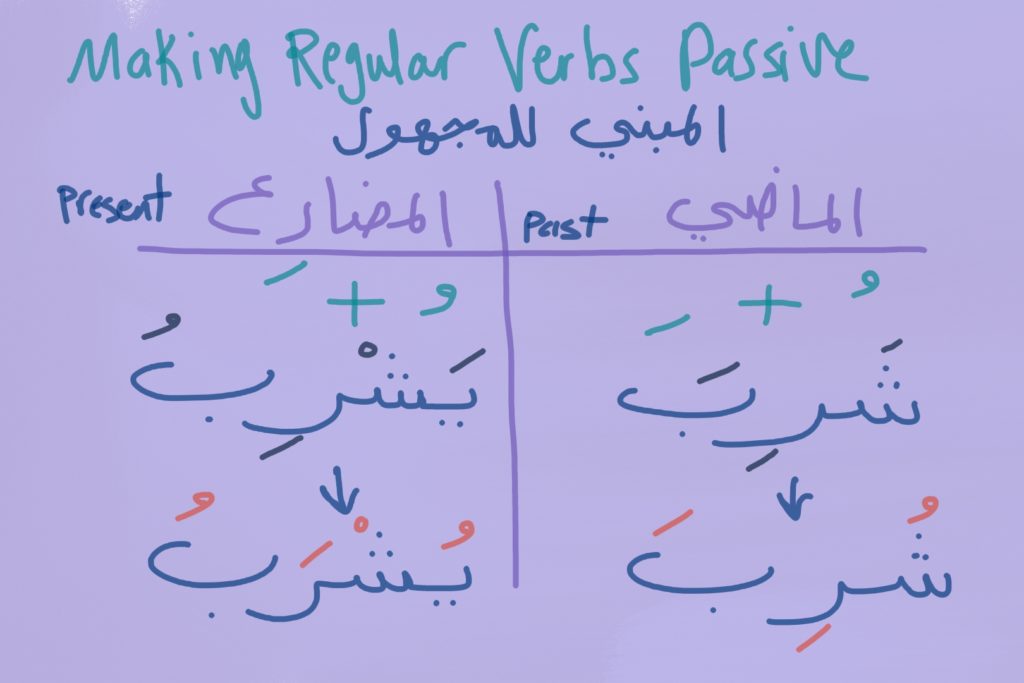Making Regular Verbs Passive in Arabic المَبني للمَجهول Posted by yasmine on Sep 22, 2021 in Arabic Language, Grammar
In this post, we’ll be reviewing some grammar. ? Before we talk about the passive form in Arabic, let’s remind ourselves what a passive sentence is in English:
- Our Arabic teacher confirmed yesterday that the vocabulary quiz is today.
- It was confirmed yesterday by our Arabic teacher that the vocabulary quiz is today.
- It was confirmed yesterday that the vocabulary quiz is today.
All three of these sentences mean the same. In sentence 1, the verb “confirmed” is active. In sentences 2 and 3, the verb “it was confirmed” is passive. The passive puts more emphasis on what is being confirmed rather than who is confirming which is not always important. Notice that in sentence 3, the subject is omitted altogether.
In English, we use the verb “to be” + passive participle to form the passive (it was confirmed, they are sold, she has been taught, etc.). Arabic forms the passive by changing the diacritics/short vowels الحَركات on the tenses.
For regular verbs:
✨To make a past tense verb into the passive: Add ضمة damma followed by كسرة kesra.
شَرِبَ “drank” active past tense
شُرِبَ “was drunk” passive past tense
✨To make a present tense verb into the passive: Add ضمة followed by a فتحة fetHa.
يَنْطُقُ “pronounces” active present tense
يُنْطَقُ “is pronounced” passive present tense
Here are some example sentences:
.لا يُنْطَق حَرْف القاف في العَرَبية العامية المِصرية
The letter qaaf is not pronounced in colloquial Egyptian Arabic.
.دُرِسَت المَقالة
The article was studied.
!سُرِقَت مِني نُقودي
My money has been stolen from me!
.ذُكِرَ هذا الخَبَر في التلفاز
This news was mentioned on the television.
.يُشْرَبُ الشاي في الزيارات العائِلية
Tea is drunk during family visits.
.طُلِبَ مِني أن أُعطي عُنواناً لهذا الكِتاب
I was asked to give a title for this book.
Basically, the passive is not as common in Arabic as in English, but you will see it from time to time. The most significant indicator of the passive is the ضمة at the beginning of both the past and present verbs.
Here are some more examples:
.يُتَوَقَّع أن يَسْقُط المَطَر بعد يَومين
Rain is expected to fall in two days.
.أُمِرَ الجَيش بالهُجوم
The army was ordered to attack.
.يُقَال أن هذا البَيت مَهجور
It is said that this house is deserted.
Note that if you were to come across the passive voice in Arabic in a text that did not provide حركات the diacritics or short vowels, you may mistake a passive verb for an active verb where it may not make sense. For example let’s take a sentence from above and and take out the حركات.
!سرقت مني نقودي
If سَرَقْتُ is “I stole”, it wouldn’t make sense because it would make the sentence ” I stole money from me.” It could be “she stole” سَرِقَت which makes sense but it may contradict the rest of the text. Therefore, when reading an Arabic text, keep track of your subjects and that will help you interpret the passive voice correctly.
I hope this post helped clarify the passive voice in Arabic. Till next week, happy Arabic learning. ?

Keep learning Arabic with us!
Build vocabulary, practice pronunciation, and more with Transparent Language Online. Available anytime, anywhere, on any device.
Share this:




